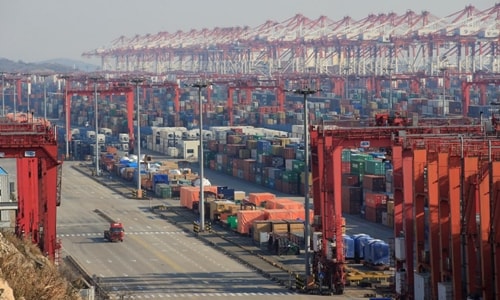3 threats to the global economy in 2018
Economists are optimistic about this year, but still worry about issues like Bitcoin and the US-China trade war.
After a relatively good economic year, analysts have made similar forecasts for 2018, as growth momentum is on track to be even higher than in 2017.Economists are confident. Nomura, for example, says: "Global growth is more self-consolidating than at any time in the past 20-30 years."
Still, they say there are three major threats to the world economy this year, stemming from central banks, trade and bubbles.
Central banks reduce monetary easing
|
Part of 2017's economic success came from a combination of record-breaking monetary easing, and efforts by central banks to ease the world into a gradual withdrawal of stimulus.
However, in 2018, the US Federal Reserve (Fed) is expected to raise interest rates three more times. The European Central Bank (ECB) is gradually reducing the scale of its asset purchase program. China is also raising its reference interest rate.
These moves are carefully considered by policymakers. But mistakes can happen. Any drastic shift could cause a sharp drop in consumption and investment.
In the US, for example, corporate debt is now nearly $8.8 trillion, according to the Securities and Financial Markets Association (Sifma). That’s up 35% since 2010 and a big drag on corporate growth.
"Compared to price stability risks, financial stability risks are a more serious threat to growth," Chetan Ahya, a researcher at Morgan Stanley, said in the 2018 outlook report.
Central banks tightening monetary policy to curb overheating or inflation will create a credit crunch, a risk not only in the US but also in Europe, Japan and China.
Global trade tensions
|
Another risk to global growth comes from US trade policy. During his election campaign, US President Donald Trump put forward the "America First" view. Upon taking office, he also made a series of moves to protect US interests, especially in trade.
The US has withdrawn from the Trans-Pacific Partnership (TPP), launched an investigation into imported steel and requested renegotiation of the North American Free Trade Agreement (NAFTA).However, the US trade deficit continued to increase, despite increased exports.The deficit with China has decreased, but it still does not satisfy Mr. Trump.
“These massive trade deficits need to come down quickly,” he said on Twitter during a visit to Asia last November.
If these words come true, the economy in 2018 will quickly turn harsh. Observers predict that in the first half of 2018, a trade war between the US and China may break out.
Mr Trump has floated the idea of a trade offensive in the hope of pressuring China to help rein in North Korea’s nuclear weapons program. Over the next few months, Mr Trump and US trade officials are expected to announce the results of major investigations (into issues like steel or intellectual property) that could lead to tariffs on Chinese imports. China last month also called on the US to abandon its Cold War mentality and “stop distorting” its strategic intentions.
Bubble burst
|
Bubbles are hard to measure until they burst. The World Bank estimates that global economic growth fell from 4.4% in 2000 to 1.9% in 2001, when the dotcom bubble burst. The financial crisis also caused growth to fall from 4.3% in 2007 to -1.7% in 2009.
The sudden loss of financial instruments would cause companies and consumers to stop spending, causing growth to slow, jobs to be laid off, and a series of defaults to occur. 2017 saw many bubbles. Bitcoin was the most obvious.
The digital currency has surged nearly 20-fold in the past year without a solid foundation, prompting economists to warn it is a “bubble of bubbles.” If Bitcoin bursts, the impact could ripple through traditional financial markets, like stocks.




